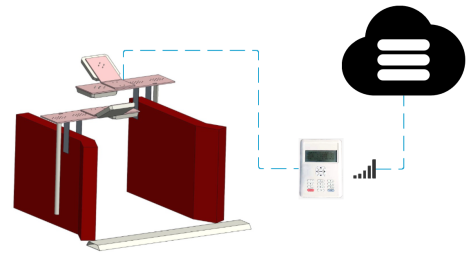Application of Electronic Ear Tag
Model ET933
Recently, Fofia Tech. has launched an ultra-high frequency RFID electronic ear tag: ET933. Compared with the low-frequency electronic ear tag, the ultra-high one is lighter in weight, lower in cost, and has a longer reading distance and is more accurate in multi-tag conflict environment. ET933 is encapsulated by non-toxic and odorless TPU/ABS polymer material, which has good sunscreen, dust-proof, and anti-soaking performance. The color of the label is yellow, which is brighter and easier to be recognized by eyes. The surface of the label can also be customized by laser marking according to special requirements. It can be used in pairs with T901, T905, T911 and other common ear tag male studs of Fofia Tech..

Characteristic of ET933 UHF Electronic Ear Tag
Compliant with international standards, the ultra-high frequency electronic tag is specially designed by Fofia Tech. for animal husbandry management.
The ear tag adopts imported European Microchips with high quality reading and writing performance and safer data.
Both open-type and closed -type on the top in outlook designs are available. After Secondary Injection Molding Process, ET933 is waterproof and anti-dropping. Together with the Fofia Tech.’s reader device series, this ear tag offers an useful solution to animal identification, feeding and food(meat) safety & traceability manageme.
It can identify high-speed moving objects, and the simultaneous reading accuracy in multiple-tags environment is the best among all types of electronic tags, with a record of maximum 300 tags once at the same moment.
Strong penetration with little effect on tag recognition whether high temperature or low temperature
Because the tag has two storage areas of global unique code and EPC, it has the best effect on product encryption and the prevention of tags replacement.
The memory capacity of data is large with 128 bit storage space.
The recognition distance is long, the longest recognition distance can reach 3-5 meters.
Application in Animal Husbandry Management
In the process of animal husbandry, Fofia wears an animal ear tag for each animal in the farm, implements one animal for one tag, deploys RFID readers and antennas at the entry and exit, and uses RFID reading and writing equipment for each animal. The whole life cycle information is automatically collected, the situation of each stage is understood, the data is recorded, and the data is uploaded to the cloud platform. Realize animal husbandry management informatization and cloud platform.

UHF animal electronic ear tags can be used in breeding management, data inventory, daily trajectory tracking, traceability and other application scenarios in the process of animal husbandry.
UHF ear tag identification is divided into mobile identification and fixed identification in animal husbandry farms. Among them, mobile identifiers are generally used for daily management, on-site data entry operations, etc.; fixed equipment is generally used for entry and exit counting, daily trajectory tracking, etc., and is deployed in the daily fixed activities of livestock.
The significance of RFID applied to Animal Husbandry Management
In recent years, animal epidemics around the world have continued to break out, such as mad cow disease, foot-and-mouth disease, avian influenza, etc., which have brought serious harm to people's health and life, and hurt the animal husbandry industry deeply all over the world. So governments of various countries have quickly formulated policies and adopted various methods to strengthen the management of animals. Among them, the use of RFID animal ear tags to identify and track animals in the source breeding process has become one of these important methods. The application of electronic ear tags in animal husbandry management is mainly reflected in the following aspects:
1. Conducive to the food safety supervision of livestock products: Take pig breeding as an example, the electronic ear tag of a pig is carried for life, which is equivalent to an animal ID card. Through the electronic ear tag, it can be traced back to the production farm of the pig in detail. , acquisition farms, slaughterhouses, supermarkets and other information on the flow of pork sales, which is conducive to cracking down on participants who endanger public food safety, such as selling sick and dead pork. The safety of domestic livestock products ensures that people can eat healthy pork meat.
2. Conducive to improving the level of breeding management: The unique identification of individuals is achieved by being equipped each livestock with uniquely coded ear tags. For example, ear tags used in pig farms mainly record the number of the farm, the number of the pig house, and the individual pig. Data such as serial numbers can be read and written by hand-held devices to achieve daily information management of individual pigs such as material management, immune management, disease management, death management, weighing management, medication management, and slaughter records.
3. Conducive to animal disease control: Electronic ear tags can manage the ear number of livestock and its breed, source, production performance, immune status, health status, animal owner and other information together. It can track (trace) its source, distinguish responsibilities, and plug loopholes, so as to realize the scientific and institutionalized animal husbandry and improve the level of animal husbandry management.
4. Conducive to safe production: Electronic ear tags are an excellent tool for clear identification and detailed management of a large number of livestock. Through electronic ear tags, farms can discover hidden dangers in time and take corresponding control measures quickly to ensure safe production.
Animal electronic tags based on RFID technology are no longer a new concept, and are rapidly developing into an important means to improve the operational efficiency of breeding places, effectively monitor animal feeding and improve the transparency of the food supply chain. At present, it has been widely used in livestock breeding tracking, identification management, and livestock slaughtering. and other aspects and fields.

